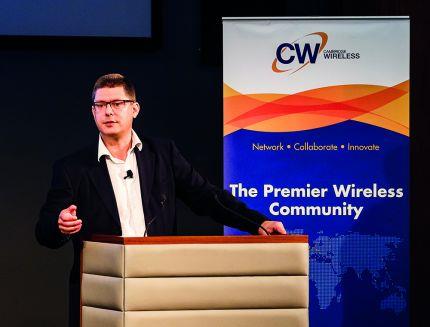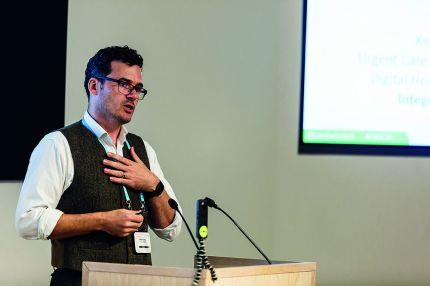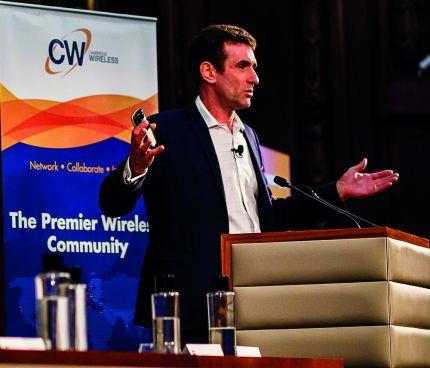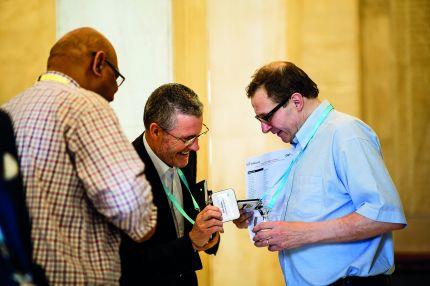The 8th Future of Wireless International Conference (FWIC), took place at IET London, Savoy Place and began with an introductory session on the conference’s overall themes – including the role and needs of verticals and innovation.
Simon Fletcher, CTO of Real Wireless and chair of the event’s organising committee, says that while 2014 was focused on exploring how to bring mobile services to emerging markets together with transformation in consumer markets, 2015 prioritised exploring the potential for disruption and the “5G vision”, which concluded that there needs to be greater attention on how this will affect and benefit verticals – and that is the focus of this year’s conference.

Simon Fletcher explained that this year's FWIC is focused on the verticals that stand to benefit from 5G
Eileen Burbidge, partner at Passion Capital, highlighted the fact that the tech sector is the fastest-growing in the UK, accounts for 11 per cent of GDP and turned over £160 billion last year. She believes that “digital technology is leading Britain into the next industrial revolution”, but the sector “could do better” in terms of commercialisation.
Jon Carter at Deutsche Telecom says his company believes that the smart home market will consolidate to three to five platforms globally and that analysts believe the likes of Google will mean there won’t be enough room in the market for MNOs. However, in his view, MNOs have the advantages of scale; for example, when it comes to consumer IoT and the millions of broadband routers in people’s homes – Deutsche Telecom believes that the router is the enabler for consumer IoT, so it is looking to use this to good effect.
Carter comments that there hasn’t been enough innovation in how the smart home can be monetised. He also states that every market is different for smart home services, noting that in Germany, the number one concern is privacy. Deutsche Telecom has invested “tens of millions of euros in an open IoT architecture” and uses Eclipse Smart Home, which is an open-source software community, and the company is focused on making best use of this community. “If as telcos we try to be proprietary or closed in terms of our approach to the market, we will fail and telecos are not the first place where you’d find innovation, so we want to go out to the industry and bring in the innovation from outside.”
Arabel Bailey, Accenture Digital UK, gave her view on platform businesses, using Uber as an example. She highlighted that they are relentlessly customer focused and can evolve in quite unpredictable ways – for example, Uber started off as a high-end service, but is now seeking to change how we view car ownership and is diversifying into vaccine deliveries. Bailey adds that platform businesses are fascinating due to “their ability to scale and disrupt entire industries with relatively little investment”. She says they are currently mostly used for peripheral transactions linked to leisure-type activities, “but not integral to our core being... I think the next wave
of platform businesses are going to start to disrupt the things that are much more fundamental to our core, often things we need at a time of crisis”, such as health and legal services, along with social care and education, which are all ripe for disruption. She notes that Philips is collaborating with Salesforce on its HealthSuite digital platform, which will collect and analyse data from medical devices and act as an aggregator of healthcare services.
I wonder if one day we’ll see an education platform that uses gamification to encourage learning, while identifying users’ strengths, steering them towards them and then gradually transitioning to a platform for employment – so someone with a talent for design, for example, could end up producing content for commercial use on the same platform that educated them. While more than a little Brave New World, it could help workers in an age where they’re competing globally and help to reduce the waste that occurs when students opt to study subjects at use of technology to allow remote patient monitoring university that they never go on to use in their working life. This approach might also help teachers pull their pupils away from the grasp of computer games.
Smart cities: waiting for take-off
Singapore is seeking to become a smart nation. Steve Leonard, chief executive at SG Innovate, says that the city-state is looking into smart city technology to address the challenges arising from its rapidly ageing population (which, according to Leonard, is ageing at a faster rate than in almost any other country in the world as a percentage of total population) and its incredible urban population density (8,500/km2, compared with 4,500-4,600/ km2 for London).
One of the key aims is to roll out ubiquitous connectivity for people and devices, as without this it would not be possible to introduce new healthcare models based around fitting patients discharged from hospitals with sensors (with their consent) to monitor their health, for example. He adds that they are performing heterogeneous networks (hetnets) trials on various parts of the island, with the aim of better understanding how people can move between Wi-Fi and cellular networks on a large scale, where it is a significant challenge. Hetnets, as their name implies, allow computers and devices running different operating systems and protocols to communicate with each other.
Moving closer to home, in late 2015, Manchester won a competition to become the UK’s Internet of Things City Demonstrator. The CityVerve consortium is made up of 22 partners including Telensa, Cisco, Siemens, BT and a number of SMEs, and it is seeking to demonstrate a smart city at scale, with the aim of providing a replicable model for other cities. Telensa will be supplying LPWA technology, which will be supported by Cisco’s City Data Platform and BT’s Data Hub.
The project, which started on 1 July, will focus on four key areas: healthcare; transport; energy and environment; and culture and community. According to Nick Chrissos, head of innovation technology, UK and Ireland, at Cisco Systems, the project will have two years to demonstrate what the “smartest of all the smart cities will look like”.
It will focus on a 2 km-long corridor in Manchester city centre, covering 7,000 students and 60,000 workers, which will be converted into a pedestrianised area.
Chrissos says that it will look at linking transport with health and social care, creating real incentives to make people walk more and use alternative methods of transport. For example, the project will also work to convert bus shelters into “safe havens”. He emphasised that it will work to change people’s behaviour using the insights gathered from the collected data. It will also introduce smart lighting, parking and air quality monitoring.
Chrissos attributed much of the bid’s success to Manchester’s high level of devolution, resulting in a very aggregated authority. “We have a situation in which Manchester City Council controls the master budgets for everything that happens in the city...
“....In the middle is a single platform that will provide the processing power to be able to have hundreds or thousands of applications and will sit on the network of networks that will be able to access and connect to everything in the city. This is the element that we want to replicate in every city,” he says.
He adds: “We looked into every smart city... we looked at the solutions that they were implementing... we tried to identify what makes a smart city. We realised that we had a collection, a cluster of solutions that were put together to address specific problems and they were flagged and put under the umbrella of ‘smart city’. We wanted to do the next thing... to create something very different.”
Despite the promise that these technologies hold, the smart city concept has been relatively slow to catch on. “We are panicking as a community because we see things aren’t really taking off,” says Mischa Dohler, co-founder of Worldsensing, an IoT company.
“If I could ask something of this community, it’s do not come up with new standards or technologies, we are just good, we’re fine. We have a lot of technologies that connect sensors, a lot of databases and AI algorithms, you name it... We just need to wait until the demand-side picks up. It’s the old story of confusing need with demand... there is a need for smart city technologies... demand is like a good bottle of wine – you open it and you have to wait.”
Part of the reason many first-responder organisations have yet to fully realise the benefits from IoT and smart cities is that many of the low-powered wide area (LPWA) technologies that allow IoT sensors to run for years without the need for battery replacements use unlicensed spectrum. Dohler notes that while this is fine for non- mission-critical use cases, it is not suitable for use in refineries or other critical applications because it isn’t possible to deliver the SLAs required by customers in these areas using this type of spectrum. This is largely because spectrum regulatory bodies, such as Ofcom here in the UK, do not offer any protections against interference in unlicensed spectrum.
Healthcare IoT: make a difference or don’t bother
One of the key reasons digital health is struggling to make an impact is that it is almost entirely focused on diagnostics, when roughly 80 per cent of healthcare spend is on the older half of the population and 90 per cent of spending on these patients is on treatment, says Dr. Shamus Husheer of Heartfelt Technologies. As a consequence, he adds that to make any cost impact, a digital health device needs to provide a lower-cost treatment or provide the means to avoid a treatment altogether. For example, while his company’s DuoFertility device monitors ovulation to aid conception, through doing so it reduces the need for IVF, to the extent that medical insurance companies in the US pay for their customers to use it.
He adds that on the face of it, consumer digital health (hardware) doesn’t make economic sense as consumers’ “friction price- point is around $100; the problem needs to be solved for $10 – with a BLE chip costing $1, you would only get to keep $2 as net profit, and would need to make an annual net profit of $1 million to matter to investors, requiring 500,000 new patients per year in the device’s exact patient group and 2.5 million per year in the disease category”. Husheer says there are fewer than 10 diseases that meet this criteria.
He says that the only true problem is ensuring patient compliance, i.e. that they take the drugs they are prescribed, they make the lifestyle changes recommended by their doctors and that they report changes in their symptoms. Husheer highlighted chronic heart failure, which is commonly compensated with diuretic treatments, but failure to adhere to them can result in lengthy and costly hospital admissions. In fact, heart failure is the most common reason for hospitalisation in the over-65s and accounts for two per cent of the NHS budget. As a result, his next company is developing a system to detect swollen feet – a key indication that a patient with chronic heart failure isn’t complying with their treatment regime – as this would reduce the reliance on patients reporting their symptoms and therefore cut costs through decreasing the need for emergency treatment.
Steve Feast, managing director of the Eastern Academic Health Science Network (EAHSN) – which works to adopt and spread innovation throughout the NHS and support service improvement – believes that employee resistance is the biggest challenge when it comes to the introduction of new technology, adding that senior managers are often fearful that their lack of technical knowledge will be revealed. He adds that all too often people come to him with products that haven’t been given a thorough economic analysis.
He believes that for every innovation that comes into the NHS, roughly half of the amount spent on new technology needs to go towards service improvement and making the cultural and social changes that drive it.
Dr Keith Grimes at Health Alert 24 spoke about his experiences with AliveCor’s Kardia, a small device that can be put on the back of a smartphone and allows the user to take single- lead electrocardiograms (ECGs) anywhere. He says that he has had some success at getting patients suffering from intermittent palpitations to record them and it helps to reduce the workload on GPs and other staff, as ECGs can be sent as PDFs and it enables remote management of patients. However, there are some issues, such as the need for it to be attached to a smart device, and it can generate “tremendous amounts of data”. Grimes also says that his team has put in a bid for some funding to use French company AMA’s Xpert Eye software in combination with Google Glass-style equipment to allow remote assessment of patients.

Dr Keith Grimes discussing the use of technology to allow remote patient monitoring
“Part of what we’re going to be doing with that in the long term is allowing paramedics and ambulance techs to wear Google Glass and then remotely access specialist clinical opinions... What we’re doing first is putting the device, which works over either Wi-Fi or mobile phone networks, in care homes to allow patients to get a GP’s opinion [remotely].”
Many of the exhibitors at the event were from companies that were either small start-ups or those that offered services to start-ups. Two in particular caught my interest. The first, Smart Antenna Technologies, a spinout company from the University of Birmingham, and its technology can replace all the antennas in a smart device with just one, and it claims that this results in significantly lower costs, better performance and frees up space in the device. The second, GTT Europe, provides assemblies, enclosures and antennas for outdoor wireless prototypes, to help its customers accelerate prototyping and product development.
Retail
Danny Bagge, retail industry lead at IBM Retail, says a survey found that “technically speaking, [the current state of online retail is] rather pants”, as conversion is at a three-year low, with only 2.5 per cent of us completing an order when we go online, and there’s been a 25 per cent drop in page views, with two- thirds of us leaving a website without buying, despite having added an item to a basket. He believes there is a big gap between customers’ expectations and what they are getting when it comes to online shopping, adding that customers think in pictures and that there needs to be greater use of unstructured content and video – and he cites Pinterest as an example.

Danny Bagge, IBM Retail, highlighted the ability of cognitive technologies such as machine learning to deliver greater insight into consumers' buying habits
Bagge adds that success comes from combining insight, technology and a respected brand, with the insights increasingly coming from cognitive technologies such as machine learning as the amount of data becomes increasingly difficult to analyse through traditional methods. He also says that there are very fast innovation platforms that retailers can take advantage of, and the resulting products/services can be easily delivered at scale using cloud services. Bagge further thinks that this combination is going to make the next few years very interesting for the retail industry.
David Dobson, senior industry advisor at Intel, says that his company is carrying out a project with Levi’s to track items in-store, all the way from newly arriving stock to leaving the shop, and that the same sensors can be used for anonymised tracking of people. Levi’s can then use this information to improve merchandising and spot products that are being consistently tried on and then not purchased.

FWIC provided attendees with many networking opportunities and featured Blendology’s OneTap technology to allow the quick exchange of contact details
Connected vehicles
Land Mobile also recently attended a Cambridge Wireless Automotive and Transport SIG meeting, which was hosted by Digital Greenwich, on the theme of “Connected vehicles: the ultimate IoT sensor?”.
At the meeting, Professor Nick Reed, academy director at Transport Research Lab (TRL), was asked by Land Mobile about the ethical problems autonomous vehicles may have to resolve, such as whether to sacrifice a passenger’s life to save the lives of others in a scenario where a crash is inevitable.
He thinks that “there’s two reasons why this is not as big an issue as it’s often made out to be. The first is that the vehicles will be inherently cautious so they’re much less likely to encounter unavoidable collisions than a human driver... The second reason is the data. When any collision [involving autonomous vehicles] occurs, there will be a huge amount of data to understand why it occurred and to understand if there are ways that the behaviour of the vehicle could or should be improved, and through over-the- air updates... all the vehicles across the fleet will learn from the mistakes of others, so we’ll very quickly get to the state of optimised driving behaviour.”
One of the activities TRL is involved in is the Bosch-led Move-UK three-year project, which is about “human-driven vehicles, with the latest automation systems from Bosch, and we’ll be able to compare how the human driver behaves with what the automation systems would have done in the same situations the driver encounters”.
Reed explained that there are five levels of automation, ranging from 1 (driver assistance) to 5 (full automation), and that Tesla’s autopilot function is at 2 (partial automation where the driver needs be aware). Reed suggested that in the recent fatal autonomous car crash, the driver had assumed that as they weren’t doing anything they didn’t need to pay attention, and notes that from the driver’s perspective there often doesn’t appear to be any difference between this and a level 3 (conditional automation system, which can function without the driver paying attention). However, he highlighted instances where Tesla’s autopilot had prevented accidents due to driver inattention. Reed adds that the Volvo Drive Me programme is testing level 3 automated vehicles. It will be giving these to 100 members of the public in Gothenburg, with parts of the city being marked as areas where no driver intervention will be required.
The displacement of labour due to automated vehicles is something that Reed believes will be difficult to bring about in an orderly manner. He adds that automation isn’t just for the cars and vehicles that we recognise today, noting MIT’s PEV – Persuasive Electric Vehicle – a trike designed to operate like a “Boris Bike” but capable of autonomously moving to areas of demand and delivering packages.
Reed discussed some of TRL’s current projects in this field, such as GATEway, an Innovate UK-funded project, which is developing autonomous shuttles for micro- transit, autonomous valet parking technologies and delivery vehicles. The delivery vehicles will operate in the University of Greenwich campus site and TRL is looking into whether they can be used to be “motherships” for Starship Technologies’ delivery robots.
The shuttle deployment has £2.4 million in funding and will involve command control, visualisation, mapping, demand control, monitoring software and developing seven six-person shuttles, which will detect obstacles using LIDAR (light detection and ranging) technology. Reed adds that it has received an incredible amount of interest from the public, not all of it positive, with some complaining to him on Twitter about it “being some sort of metropolitan elite wanting to take people out of their cars and take away independence”.
Alec McCullie, head of connected and autonomous vehicles at KPMG LLP, suggested that innovations in manufacturing, such as the use of machine learning, could lead to a demand-driven supply chain, and the ‘age of the artisan’ in which mass production is coupled with massive customisation and short design cycles and people are freed to focus on making more relevant and skill- intensive products. He also expects the future of the automotive industry to be less traditional hardware design and more about the experience of getting from A to B.
KPMG is also predicting that connected car and autonomous vehicle tech will increase the number of miles travelled, particularly among children, 16- to 24-year-olds and the over-54s – as set out in its November 2015 report ‘The Clockspeed Dilemma’.
Andy Graham, intelligent transport systems consultant at White Willow Consulting, believes that the tipping point will come when connected car features are present in entry-level/mass-market new cars, and notes this has already begun, citing the Vauxhall Viva, which is available for £200/month and comes with eCall, built-in Wi-Fi, vehicle diagnostics and a smartphone function to allow limited remote control.
Graham says that there are powerful incentives for highways authorities to make use of data from vehicles, saying that doing so could cut the amount of salt needed on the road in winter by 20 per cent, saving £20 million. As the annual spend on UK roads is around £5 billion, even a one per cent saving would equate to £50 million. He expects there to be growth in the retrofit market, in terms of equipping older vehicles with connectivity, but adds that the only problem with this is that “old vehicles aren’t getting safer” and, as a result, “young people die in old vehicles”.
While Brexit has no doubt cast something of a shadow over R&D in the UK, given the importance of EU funding under Horizon 2020 – its framework programme for research and innovation – when I look back on both events, it’s hard not to be impressed at the sheer amount of innovation on display and its potential. However, in this new and uncertain world, there will be a greater need for government to play an active role in ensuring that this country benefits from the ingenuity of its citizens.
Photography by linaandtom.com
This article has been amended to correct the spelling of Nick Reed's surname



